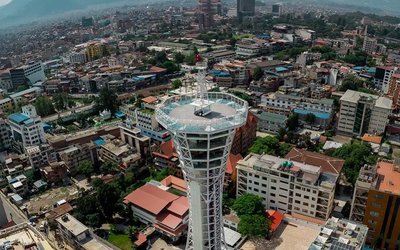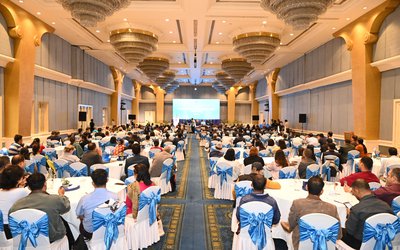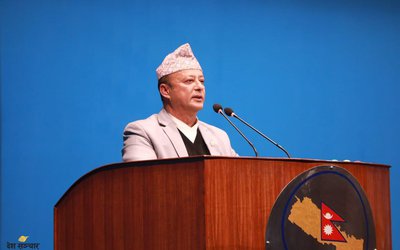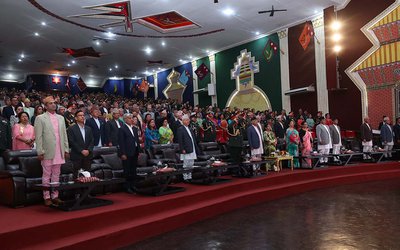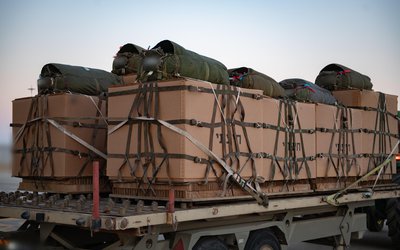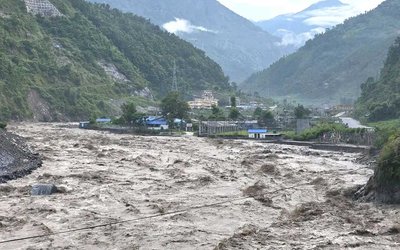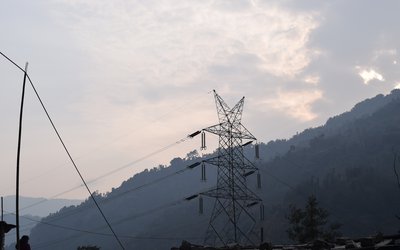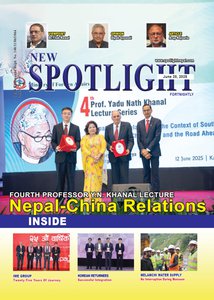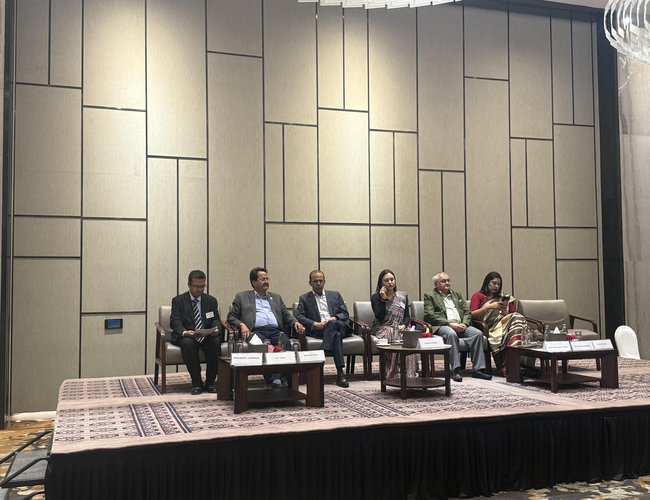
The world is currently experiencing a period of uncertainty and significant change, marked by a shift towards a new world order characterized by multilateralism, terrorism, mistrust, and conflict. This shift is particularly evident in regions such as South Asia and the Middle East, where terrorism has become a major threat to peace and security. With a population of over 1.9 billion people, South Asia is a region that continues to grapple with the challenges posed by terrorism. Factors such as state sponsorship, porous borders, ideological extremism, and weak governance contribute to the prevalence of terrorism in the region.
South Asia remains vulnerable to terrorism due to its complex historical, political, and socio-economic landscape, which provides fertile ground for extremist activities. From the resurgence of the Taliban in Afghanistan to cross-border militancy in Kashmir, terrorism undermines governance, economic growth, and the overall security of the region.
The main challenges in combating terrorism in South Asia require strong and committed strategies for regional and international cooperation. Nepal could not remain isolated while the world was dealing with extremism and terrorism. In the late seventies, neighboring countries such as Sri Lanka, Pakistan, Maldives, Bangladesh, and Northeast states in India were facing separatism, extremism, and terrorism. Nepal also experienced terrorism and insurgency, including Marxist-Leninist terrorism in Jhapa. The Jhapa Rebellion (1969–1971) involved violent activities associated with a peasant-led armed insurgency that evolved into a guerrilla campaign. The Khampa Movement in Nepal, also known as the Khampa Insurgency or Khampa Disarming Operation, was a significant historical event involving Tibetan resistance fighters known as Khampas operating from Nepalese territory against Chinese forces in Tibet during the 1960s and early 1970s. The Khampa Movement in Nepal was a complex interplay of regional resistance and Cold War geopolitics. The insurgency was effectively resolved through a disarming operation in 1974, which involved military action and the Dalai Lama's intervention.
The Maoist insurgency in Nepal was a complex conflict driven by systemic inequalities and political failures. Its resolution through the 2006 Comprehensive Peace Agreement (CPA) marked a significant step toward democracy, but challenges such as transitional justice, political instability, and socio-economic disparities persist. Nepal’s peace process serves as a reminder that violence cannot bring about lasting change, and that dialogue and democracy are essential tools for conflict resolution. Sustainable peace requires addressing root causes through inclusive governance, economic development, and accountability for past atrocities. Nepal's successful multilateral effort in resolving the conflict, with India playing a key role in the international community's response, highlights the importance of cooperation in achieving peace.
The open border between Nepal and India, spanning 1,751 kilometers, is a unique aspect of our bilateral relationship established by the 1950 Treaty of Peace and Friendship. While it enhances cultural, social, and economic connections, it also presents significant security challenges. Nepal faces issues such as cross-border terrorism, infiltration, and radicalization, particularly from Pakistani-based organizations. There is a risk that Nepal could become a transit hub or safe haven for terrorist groups like Lashkar-e-Taiba and Jaish-e-Mohammed, both of which are UN-designated terrorist organizations with historical ties to Al-Qaeda and operate in Pakistan. This poses security risks for India and the potential for these groups to use Nepal as a base for their activities.
This could potentially destabilize Nepal's internal security, especially in border regions, as there have been instances of Pakistani groups exploiting the open border in the past. For example, in the 2008 Mumbai attacks, terrorists reportedly used Nepal as a transit point. Historical incidents, such as the 1999 Indian Airlines Flight 814 hijacking, also demonstrate Nepal's vulnerability to being used by terrorist groups.
The existing mechanisms, such as the 1950 Treaty of Peace and Friendship, the Extradition Treaty (1953, amended 2019), the Mutual Legal Assistance Treaty (2005), and the Joint Working Group on Border Management (JWGBM), provide a foundation for cooperation between Nepal and India. However, these mechanisms may not be sufficient to fully address the sophisticated threat of cross-border terrorism. Gaps in technology, real-time coordination, and Nepal's resource constraints pose challenges, particularly given the unique challenges of the open border.
Both Nepal and India should enhance bilateral cooperation by regularly meeting to review and coordinate efforts to counter these threats. This can be achieved through measures such as: 1 Enhancing Border Security and Surveillance,
2 Utilizing Advanced Surveillance Technologies, Enhancing Intelligence Sharing, and Strengthening Counterterrorism Coordination,
3 Improving Extradition and Legal Cooperation: Enhance the India-Nepal Extradition Treaty to facilitate the swift extradition of terrorists and criminals. Align legal definitions of terrorism to prevent loopholes. Streamline Extradition Procedures: Simplify processes outlined in the Extradition Treaty to ensure prompt transfer of terrorist suspects, with defined timelines and reduced bureaucratic obstacles.
4 Developing a
Bilateral Counterterrorism Agreement: Formulate a dedicated agreement focusing on combating cross-border terrorism, including provisions for joint investigations, sharing of evidence, and mutual legal support.
5 Enhancing Cybersecurity Measures and Financial Tracking,
These measures will promote effective coordination and security while preserving the unique strengths of the India-Nepal relationship.
India, a diverse and vast nation in South Asia, confronts a multifaceted terrorism landscape influenced by its geopolitical positioning, internal socio-political dynamics, and regional rivalries. The country grapples with various forms of terrorism, such as Islamist extremism, separatist insurgencies, left-wing extremism (Maoist/Naxalite), and cross-border militancy, particularly from Pakistan-based groups.
The issue of regional terrorism between India and Pakistan remains volatile, fueled by the Kashmir conflict, allegations, and the actions of organizations like LeT and JeM. The 2025 Pahalgam attack and subsequent military confrontations underscore the risks of escalation, including nuclear brinkmanship and technological warfare.
Pakistan confronts an enduring and evolving terrorism threat, driven by a complex interplay of Islamist militancy, separatist uprisings, and cross-border dynamics, especially along its Afghan border. The nation's terrorism landscape is influenced by historical state strategies, regional geopolitics, and socio-economic difficulties.
Similarly, Pakistan is affected by the instability in Afghanistan, as groups like Tehrik-i-Taliban Pakistan (TTP) take advantage of porous borders. This situation hampers intelligence sharing and joint counterterrorism efforts.
Sri Lanka has faced regional terrorism mainly through the activities of the Janatha Vimukthi Peramuna (JVP) and the Liberation Tigers of Tamil Eelam (LTTE), two distinct groups with different ideologies and strategies that have influenced the country's violent history. The JVP is now a mainstream political party led by President Anura Kumara Dissanayake.
Despite its reputation as a tourist paradise, the Maldives grapples with a complex terrorism landscape, including concerns about radicalization, violent extremism, and the presence of terrorist operatives linked to groups like ISIS and al-Qaeda.
Bangladesh has made progress in reducing terrorist incidents since 2016 through strong counterterrorism measures and international assistance. However, ongoing challenges include political instability, radicalization risks, and reported releases of extremists in 2024.
Terrorism in South Asia takes various forms, such as religious extremism, separatist insurgencies, and state-sponsored militancy. Key groups include the Taliban, Lashkar-e-Taiba (LeT), Jaish-e-Mohammed (JeM), and the recent attack targeting Hindu tourists in Baisaran Valley near Pahalgam on April 22, 2025, attributed to the Pakistan-based LeT offshoot, The Resistance Front (TRF). The Nepal government expressed strong condemnation for the terrorist attack in Pahalgam, Jammu and Kashmir, on April 23, 2025, especially considering the tragic loss of a Nepali citizen. I, too, strongly condemned the cowardly act of violence against the innocent victims. Nepal remains steadfast in its support for India on this matter. Nepal swiftly condemned the attack and expressed solidarity with India.
According to the Global Terrorism Index 2024, Afghanistan remains the center of terrorism, with 1,426 incidents in 2023, while Pakistan and India also rank among the top ten globally for terrorism-related deaths. The region's diverse ethnic, religious, and linguistic makeup fuels grievances that terrorist groups exploit.
Key Challenges to Countering Terrorism
- State Sponsorship and Cross-Border Tensions
Allegations of state sponsorship and support for groups like LeT and JeM, aimed at influencing Kashmir, have strained bilateral relations. Similarly, Afghanistan's ongoing cross-border activities spill over into Pakistan, with groups like Tehrik-i-Taliban Pakistan (TTP) taking advantage of porous borders. These tensions impede intelligence sharing and joint counterterrorism operations.
Porous Borders and Transnational Networks
The geography of South Asia, characterized by rugged terrains and poorly monitored borders, facilitates the movement of terrorists, arms, and illicit funds. The Durand Line between Afghanistan and Pakistan is a well-known route for militant activities. Transnational networks, including those associated with Al-Qaeda and ISIS, add complexity to efforts to disrupt terrorist infrastructure.
Socio-Economic Factors
Factors such as poverty, unemployment, and lack of education create conditions conducive to radicalization. In Bangladesh, for instance, rapid urbanization and economic disparities have contributed to the recruitment efforts of groups like Jamaat-ul-Mujahideen Bangladesh (JMB). Similarly, in Sri Lanka, longstanding ethnic tensions from the civil war have been exploited by extremist groups, as evidenced by the 2019 Easter bombings.
Weak Governance, Inefficiency, and Corruption
Weak institutional frameworks, inefficiency, and corruption hinder counterterrorism measures. Corruption remains a significant challenge in South Asia, undermining governance, economic progress, and public trust in government institutions. Countries in the region, including India, Pakistan, Bangladesh, the Maldives, Sri Lanka, Afghanistan, Nepal, and Bhutan, face systemic issues such as bribery, nepotism, and misappropriation of public funds, often exacerbated by political instability, weak judicial systems, and socio-economic disparities. The Taliban's takeover of Afghanistan in 2021 highlighted the fragility of governance structures in the country. Corruption also facilitates terrorist financing, with illicit funds moving through informal hawala networks.
Ideological Extremism and Online Radicalization
The proliferation of digital platforms has magnified extremist propaganda. Groups such as ISIS utilize social media to recruit and radicalize young people throughout South Asia. The absence of a unified regional approach to regulating online content complicates efforts to combat this trend, which includes terrorism, cross-border infiltration, radicalization, and attacks by Pakistan-based terrorist organizations. Strengthening bilateral cooperation to tackle these threats necessitates a comprehensive strategy that incorporates intelligence-sharing, border management, counter-radicalization initiatives, and diplomatic collaboration.
The resurgence of the Taliban in 2021 has emboldened groups like ISIS-Khorasan, which carried out 184 attacks in 2023. The lack of a cohesive counterterrorism strategy and limited international involvement heighten the danger, with repercussions felt across the region.
Terrorism in South Asia, fueled by instability, internal conflicts, and local insurgencies, poses a significant risk to regional stability. The escalation between India and Pakistan in 2025, alongside the emergence of IS-K and ongoing smaller-scale threats in Bangladesh and other areas, underscores the necessity for synchronized counterterrorism efforts, political discussions, and socioeconomic reforms. However, geopolitical rivalries and mistrust impede progress, leaving the region susceptible to further violence.
Regional Initiatives:
BIMSTEC Counterterrorism Collaboration: Nepal and India are engaged in the Bay of Bengal Initiative for Multi-Sectoral Technical and Economic Cooperation (BIMSTEC), which includes a working group on counterterrorism and transnational crime to address security challenges in the region.
In South Asia, we are currently engaged in a new initiative with BIMSTEC, which offers Nepal a valuable opportunity to focus on counterterrorism efforts, including the establishment of joint task forces and intelligence sharing. By adopting a regional counterterrorism framework similar to ASEAN's approach, we can improve coordination in combating terrorism in the region.
Each country has its own unique foreign policy perspective, and Nepal is no exception in shaping its future. Nepal has long struggled with regional terrorism and violence, which have hindered its economic development. The economic progress of South Asia has also been affected by extremist violence, which undermines the rule of law and democratic governance. What is needed now is a strong alliance based on democratic principles, cultural exchanges, and a shared vision for combating terrorism and extremism effectively. Bilateral cooperation alone is insufficient, as terrorist activities transcend borders and jurisdictions.
Regional cooperation is essential in addressing these challenges. I am confident that the time is ripe for
South Asia, particularly for BIMSTEC, to take a proactive stance in this regard.
With regional efforts against terrorism, India can advocate for the adoption of a global terrorism treaty, the Comprehensive Convention on International Terrorism. The fourth BIMSTEC summit in Kathmandu on August 31, 2018, achieved what SAARC could not. Nepal's Legislature Parliament endorsed a BIMSTEC convention on security issues like combating terrorism, organized crime, and drug trafficking on August 21, 2018.
Enhancing Governance
Improving institutional capacity, anti-corruption measures, and judicial reforms is crucial. Bangladesh's success with community policing and de-radicalization programs can serve as a model for other countries.
Economic Development and Education
Addressing socio-economic disparities through inclusive growth and education can help prevent radicalization and discourage youth from joining extremist groups.
Combatting Online Radicalization
South Asian nations should collaborate with tech companies to monitor and remove extremist content. Public awareness campaigns and counter-narratives can challenge extremist ideologies.
International Support
Global powers like India, the U.S., and the E.U. should provide funding, training, and technology transfers for counterterrorism efforts in South Asia. The UN's Counter-Terrorism Office could offer tailored capacity-building programs for the region.
Terrorism in South Asia remains a significant threat to regional security and stability. Addressing these challenges requires a comprehensive approach that includes regional cooperation, governance reforms, and international assistance. By tackling root causes and building trust among nations, South Asia can progress towards a more secure and stable future. I have shared my thoughts on integrating South Asia through BIMSTEC. Our region shares common goals of democracy, religious beliefs, and a shared history, which bind all BIMSTEC nations together. However, we must also acknowledge the common security challenges we face and respond resolutely to them. I believe that the seminar on "Terrorism in South Asia: Challenges to Regional Peace and Security" will help promote the concept of BIMSTEC as an effective multilateral forum for economic growth in our region.
The stability of our region and the success or failure of conflict resolution initiatives in the 21st century will rely on exploring new ideas, ideologies, and strategies to achieve political consensus and a collective will to implement counter-terrorism measures. Addressing the threat of extremism and terrorism in South Asia can be best achieved through trust, dialogue, and cooperation at various levels.
Sunil Bahadur Thapa, a former minister and member of the Nepali Congress Central Committee and former employee of UNHCR, is currently serving as the Chief Political Advisor to President Ram Chandra Paudel. Excepts of a keynote address delivered at the Terrorism in South Asia: Challenges to Regional Peace and Security event organized by NIICE.
The opinions expressed in the article are solely Autor’s own and may not reflect those of the organization he is affiliated with.


